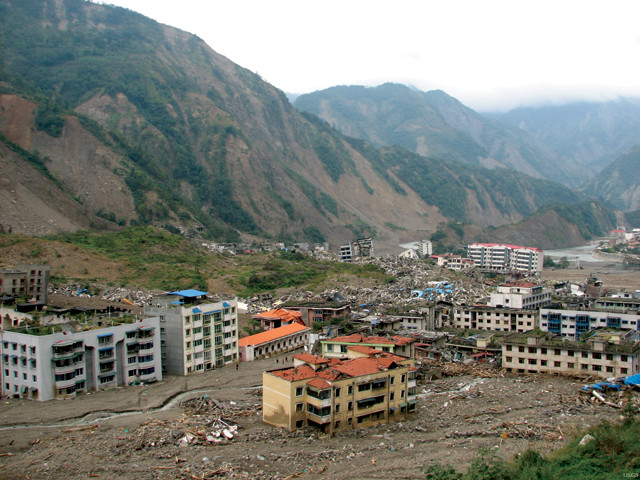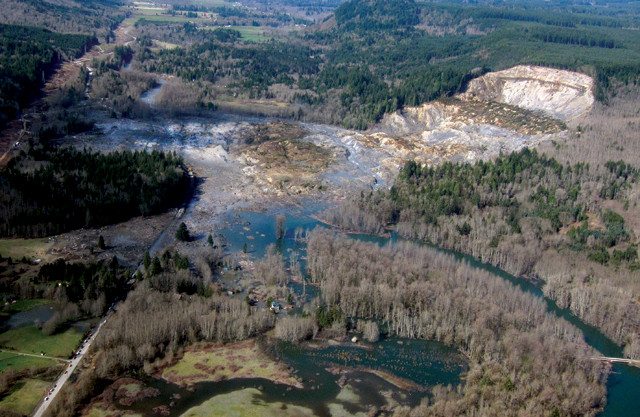
by Jane Palmer Thursday, February 15, 2018

The town of Qushan in Beichuan County, China, was destroyed by strong shaking from the 2008 Wenchuan earthquake and subsequent catastrophic landslides. Credit: David Wald, USGS.
Sensitive instruments installed on and near the slow-moving landslide in Maca, Peru, have allowed scientists to observe the response of the landslide to earthquakes: information that can help researchers predict hazards from other slow-moving landslides in the region and perhaps around the world. But scientists are wondering whether the findings could also shed light on the triggering of fast-moving landslides by earthquakes.
Typically, when an earthquake or other event causes a fast-moving landslide, the slide only lasts minutes to hours. Even when some instruments are on site, they can be destroyed in the slide, or they may not actually collect much data because the sliding happens so quickly, says William Schulz of the Landslide Hazards Program at the U.S. Geological Survey in Golden, Colo. “But you can study a landslide moving in slow motion with a much greater level of detail,” Schulz says. Whether a landslide is moving quickly or is merely creeping along, the various drivers and mechanisms of motion are similar, albeit of differing levels of importance, Schulz says.
Currently, when engineers try to predict whether earthquakes will trigger landslides in a region, they do so using calculations that include many conservative assumptions about the behavior of landslide-prone slopes. “We’re probably in a position where we can make some broad generalizations, enough to make relevant decisions about the stability of slopes and whether landslides will activate or reactivate in response to shaking,” says Bill Murphy, a geoscientist at the University of Leeds in England. But these estimates are approximations at best, and whether the study of slow-moving landslides helps scientists understand this challenge is debatable, Murphy says.
These approximations hinge on estimates of the shear strength — a material’s resistance to sliding — of the soil and rocks on a hillside. In general, Murphy says, the more the ground moves, the weaker it gets — it’s a phenomenon known as strain softening, whereby the ground’s shear strength is reduced. As a landslide moves farther, the soils and rocks entrained in it eventually reach their residual, or ultimate, shear strength and, in theory, a landslide material’s strength can’t be reduced any more, Murphy says. The shear strength of the local soil and rock is the primary control on whether a landslide will occur and how mobile it is. Under the laws of gravity, residual shear strength rarely changes. But when seismic waves hit, that residual shear strength can vary, Schulz says.
To investigate the impact of earthquakes on this crucial variable, Schulz and Gonghui Wang from the Disaster Prevention Research Institute, in Kyoto, Japan, examined samples from two landslides on the Oregon coast: the Johnson Creek and Carmel Knoll slides. In the laboratory, the scientists simulated the impacts of seismic stress on these samples and found that the residual shear strength could vary, albeit in a complex, nonlinear way.

Scientists are trying to determine if slow-moving landslides like the Maca slide can provide lessons about fast-moving landslides, like the 2014 Oso landslide in Washington shown here. Credit: Mark Reid, USGS.
From their findings, reported in 2014 in the Journal of Geophysical Research: Earth Surface, the researchers hypothesized that it takes high stresses, delivered quickly, to impact shear strength — exactly the type of stress that a sizable earthquake could deliver. Their study was the first to subject fully developed shear zones to simulated seismic stress. But previous studies, which had applied variable rates of stress to landslide samples, had reached similar conclusions. “The results suggest that many dormant and seasonally active landslides along the Oregon Coast similar to those we studied may fail catastrophically during the next great earthquake that occurs on the Cascadia Subduction Zone,” Schulz says. “However, there is great variability in landslide materials and their response to seismic loading, and scientists are really only beginning to identify the material controls.”
One challenge is that the behavior of material on hillsides is highly dependent on the amplitudes of seismic waves that pass by, but this is rarely measured. Seismologists typically place their instruments on flat ground, rather than on slopes. “The end result is that good strong motion records, namely, the records of the effects of strong earthquakes on slopes, are relatively poorly constrained,” Murphy says.
Additionally, he says, deductions from a landslide on one slope are not necessarily transferable to all similar slopes due to differences in materials, water runoff or underlying structure. “Given the complexity of earth materials, water pressures and wave propagation in a large landslide system, such [comparisons] are actually quite difficult,” Murphy says. “There are so many uncertainties that, in any given circumstance, make for a very complicated picture.”
Schulz agrees. “Although earthquake-triggered landslides have considerable effects, which has resulted in many studies of controls on their occurrence and mobility, we still are far from able to accurately predict where they will happen, how large they will be, and how far they will move,” he says.
Nonetheless, Murphy adds, “if I were looking at a steep slope with evidence of existing landslides, it would immediately be ringing alarm bells in my mind about whether more slope movement would occur during an earthquake.”
Another issue debated among scientists is whether earthquakes are more likely to trigger new landslides or to reactivate old ones. Research suggests that most landslides that occur during an earthquake are new slides, Murphy says. But, Schulz points out, many of these are smaller landslides. Most of the large landslides that are triggered by an earthquake are reactivated slides, Schulz says. “Detailed studies of large, and often catastrophic landslides produced during many recent earthquakes demonstrate that they were reactivations,” according to Schulz, “which is a critical finding from a hazard-reduction standpoint because we can identify these old landslides much more readily than we can accurately identify future landslides.”
© 2008-2021. All rights reserved. Any copying, redistribution or retransmission of any of the contents of this service without the expressed written permission of the American Geosciences Institute is expressly prohibited. Click here for all copyright requests.